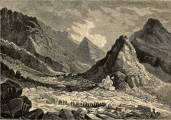


The Alabama Stone and Building Industry in 1882
Excerpts from
Mineral Resources of the United States, 1882
J. S. Powell, Director, Department of the Interior, United States
Geological Survey,
Government Printing Office, Washington, D. C., 1883.
Excerpts from the chapters on 1) "Structural Materials," and 2) "The Useful Minerals of the United States:
"The division of the Tenth Census charged with the collection of statistics of building stone obtained returns from 1,525 quarries in the United States, having an invested capital of $25,414,497, and producing during the year ending May 31, 1880, 115,380,133 cubic feet of stone, valued at $18,365,055. In value of total product, the leading States rank as follows: Ohio, Pennsylvania, Vermont, Massachusetts, Illinois, New York, Maine, and Connecticut; each of these States producing upwards of $1,000,000 worth of stone. Vermont, Illinois, Ohio, Iowa, Indiana, New York, and Missouri, in the order named, produce the most marble and limestone; Ohio, New York, Connecticut, and Pennsylvania, the greater part of the sandstone; Massachusetts and Maine quarry the most granite and other siliceous crystalline rocks; while Pennsylvania leads in product of slate."
Marble:
White marble four miles west of Talladega, and also at several points southwest near Syllacogga in same county. This is the "Talladega marble." A black marble is obtained in the localities southwest of Talladega. White, crystalline marble at Chewacla lime works, Lee county; and northeast and southwest for several miles. A non-crystalline, compact grey and white marble is quarried at Marion. Many localities in Trenton and magnesian limestone formations in valley of Cahaba river in Bibb and Shelby counties. Variegated marbles (sub-Carboniferous) and widely distributed in the Tennessee valley; works at Dickson, Colbert county; many localities in Lauderdale, Limestone, Madison, and Jackson counties; other outcrops along sub-Carboniferous rocks in the valleys from Georgia line southwest to center of State. A Tertiary white and yellow crystalline limestone occurs at Gainestown, Clark county.
ALABAMA1
Reported by John C. Smock.
Ores, minerals, and mineral substances of industrial importance, which are at present mined.
Flagging stone: In the yellow sandstone of Red Mountain group, valley from Brickville to Saint Clair Springs and at Pratt's ferry on Cahaba river. Sandstone flags of Coal Measures, Plank Shoals, on North river, Tuscaloosa county.
Thin-bedded limestones in Lower Silurian and in sub-Carboniferous group. Also gneisses and mica schists of metamorphic region.
Fine quarries at Tallahassee falls on Tallapoosa river, in siliceous slates (itacolumite). Same rock quarried at Farrell's mill and other localities in Lee county. Many localities opened for local supply.
Granite: Localities in the metamorphic region. Worked for local supply mainly. New Bradford and also Rockford, Coosa county; Notasulga, Macon county; Auburn and Chewacla, Lee county; Tallahassee, in Tallapoosa county; Milltown, Chambers county. Not properly granites, but thick-bedded gneisses.
Marble: White marble four miles west of Talladega, and also at several points southwest near Syllacogga in same county. This is the "Talladega marble." A black marble is obtained in the localities southwest of Talladega. White, crystalline marble at Chewacla lime works, Lee county; and northeast and southwest for several miles. A non-crystalline, compact grey and white marble is quarried at Marion. Many localities in Trenton and magnesian limestone formations in valley of Cahaba river in Bibb and Shelby counties. Variegated marbles (sub-Carboniferous) and widely distributed in the Tennessee valley; works at Dickson, Colbert county; many localities in Lauderdale, Limestone, Madison, and Jackson counties; other outcrops along sub-Carboniferous rocks in the valleys from Georgia line southwest to center of State. A Tertiary white and yellow crystalline limestone occurs at Gainestown, Clark county.
Millstones and Grindstones: Millstone grit has been quarried at many points in its outcrops for millstones. Near Pikeville, Marion county, a ferruginous conglomerate is widely used. A siliceous rock of Lower Eocene, in Choctaw, Clarke, Monroe, Butler, Crenshaw, and Pike counties sometimes used as a buhrstone.
Granite of Coosa, Tallapoosa, Chambers, and Randloph counties made into millstones almost of "flat rock" out-crop.
Chewacla lime works - a porphyritic gneiss quarried for millstones.
Grindstones are made in southwest part of Talladaga county (magnesian limestone horizon). Whetstones made from sandstones quarried near Eldridge, Walker county.
Sandstone: Potsdam sandstone in Calhoun and Talladega counties. Sandstone of Coal Measures quarried in Cullman county, quarried for furnace linings; T. 23, R. 25 E, in Chambers county, used for headstones; Randolph county. Clay county; ancient excavations in Tallapoosa, Chambers, Coosa, Clay, and Lee counties.
Ores, minerals, and mineral substances of industrial importance and known occurrence, but which are not at present mined.
Slate (for roofing): T. 21, R. 3 E., in Talladega county; Buxahatchee creek, in Shelby county; and in T. 19, R. 7 E., Clay county. No quarries working.
1 Mineral Resources of the United States, Calendar Year 1882, page 667 footnote: Revised and enlarged by Prof. Eugene A. Smith, of Tuscaloosa, State Geologist.
Commercial use of material within this site is strictly prohibited. It is not to be captured, reworked, and placed inside another web site ©. All rights reserved. Peggy B. and George (Pat) Perazzo.